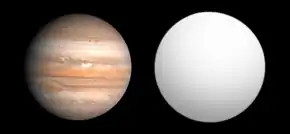 Size comparison of WASP-8b with Jupiter. | |
| Discovery[1] | |
|---|---|
| Discovered by | Cameron et al. (SuperWASP) |
| Discovery date | April 1, 2008 |
| Transit | |
| Orbital characteristics[2] | |
| 0.0817±0.0006 AU[3] | |
| Eccentricity | 0.3057±0.0046 |
| 8.158715±0.000016 d | |
| Inclination | 88.51°±0.09°[3] |
| 274.21°±0.33° | |
| Semi-amplitude | 221.65±1.39 m/s |
| Star | WASP-8 |
| Physical characteristics[3] | |
Mean radius | 1.165±0.032 RJ |
| Mass | 2.216±0.035 MJ |
Mean density | 1.7370±0.1325 g/cm3 |
| 42.5±2.3 m/s2 (4.34 g) | |
| Temperature | 1552±85 K (1,279 °C; 2,334 °F)[4] |
WASP-8b is an exoplanet orbiting the star WASP-8A in the constellation of Sculptor. The star is similar to the Sun and forms a binary star with a red dwarf star (WASP-8B) of half the Sun's mass that orbits WASP-8A 4.5 arcseconds away. The system is 294 light-years (90 parsecs) away and is therefore located closer to Earth than many other star systems that are known to feature planets similar to WASP-8b. The planet and its parent star were discovered in the SuperWASP batch -6b to -15b. On 1 April 2008, Dr. Don Pollacco of Queen's University Belfast announced them at the RAS National Astronomy Meeting (NAM 2008).[5]
Orbit
The planet orbits WASP-8A at an average distance of just 0.08 AU (12,000,000 km) and a year passes in slightly more than 8.1 days on WASP-8b, which is somewhat farther from its parent star than other hot Jupiter planets. However, WASP-8b's orbit also has an relatively high eccentricity of 0.3, which, at periastron, brings it as close to its star as said similar planets are.
One thing that stands out extremely about WASP-8b is its orbit-spin angle to its star of 123°+3.4°
−4.4°: This implies that the planet actually orbits retrograde to the spin of the parent star.[6][1][7]
Physical characteristics
WASP-8b belongs to a class of extrasolar planets known as hot Jupiters and has a mass about 2.2 times and a radius slightly bigger than that of the planet Jupiter. Its density is about 1.737 g/cm3; this implies that, unlike similar close-orbiting gas giants, the planet is actually denser than Jupiter (which has a density of 1.326 g/cm3).[8]
Owing to its close distance to its star, WASP-8b is extremely hot: Its measured dayside temperature is 1,552 K (1,279 °C), this is even hotter than its equilibrium temperature of 947 K (674 °C).[8][4]
See also
References
- 1 2 Didier Queloz; et al. (2010). "WASP-8b: a retrograde transiting planet in a multiple system". Astronomy and Astrophysics. 517: L1. arXiv:1006.5089. Bibcode:2010A&A...517L...1Q. doi:10.1051/0004-6361/201014768. S2CID 35774603.
- ↑ Bonomo, A. S.; Desidera, S.; et al. (June 2017). "The GAPS Programme with HARPS-N at TNG. XIV. Investigating giant planet migration history via improved eccentricity and mass determination for 231 transiting planets". Astronomy & Astrophysics. 602: A107. arXiv:1704.00373. Bibcode:2017A&A...602A.107B. doi:10.1051/0004-6361/201629882.
- 1 2 3 Southworth, J.; Bohn, A. J.; Kenworthy, M. A.; Ginski, C.; Mancini, L. (2020), "A multiplicity study of transiting exoplanet host stars", Astronomy & Astrophysics, 635: A74, arXiv:2001.08225, Bibcode:2020A&A...635A..74S, doi:10.1051/0004-6361/201937334, S2CID 210860775
- 1 2 Cubillos, Patricio; Harrington, Joseph; et al. (May 2013). "WASP-8b: Characterization of a Cool and Eccentric Exoplanet with Spitzer". The Astrophysical Journal. 768 (1): 42. arXiv:1303.5468. Bibcode:2013ApJ...768...42C. doi:10.1088/0004-637X/768/1/42.
- ↑ "SuperWASP scoops ten exoplanets in six months". Astronomy Now. 2008-04-01.
- ↑ European Southern Observatory. "Artist's impression of an exoplanet WASP 8b in a retrograde orbit".
- ↑ Albrecht, Simon; Winn, Joshua N.; Johnson, John A.; Howard, Andrew W.; Marcy, Geoffrey W.; Butler, R. Paul; Arriagada, Pamela; Crane, Jeffrey D.; Shectman, Stephen A.; Thompson, Ian B.; Hirano, Teruyuki; Bakos, Gaspar; Hartman, Joel D. (2012), "Obliquities of Hot Jupiter Host Stars: Evidence for Tidal Interactions and Primordial Misalignments", The Astrophysical Journal, 757 (1): 18, arXiv:1206.6105, Bibcode:2012ApJ...757...18A, doi:10.1088/0004-637X/757/1/18, S2CID 17174530
- 1 2 Bohn, A. J.; Southworth, J.; Ginski, C.; Kenworthy, M. A.; Maxted, P. F. L.; Evans, D. F. (2020), "A multiplicity study of transiting exoplanet host stars", Astronomy & Astrophysics, 635: A73, arXiv:2001.08224, Bibcode:2020A&A...635A..73B, doi:10.1051/0004-6361/201937127, S2CID 210861118
External links
![]() Media related to WASP-8b at Wikimedia Commons
Media related to WASP-8b at Wikimedia Commons